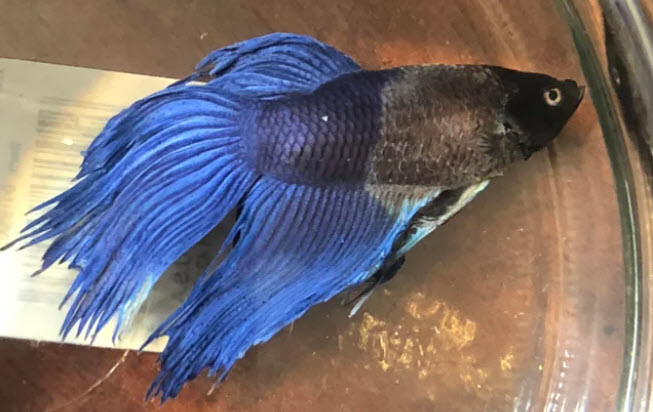
There is a disease of blue or black bettas where the fish has fins which disintegrate and/or gets dark metallic gray patches on its body. The key point here is the name “GRAPHITE“. This is called “graphite disease” because it looks just like dark gray metallic graphite. Here is what graphite looks like:

The well-intentioned commentators on social media then tell everyone that “graphite disease” is caused by oodinium. This is incorrect. Oodinium or “velvet” is tiny gold specs. If there is no tiny gold specs, it is NOT oodinium. So a solid dark gray coloration CANNOT be oodinium. This is what oodinium looks like:
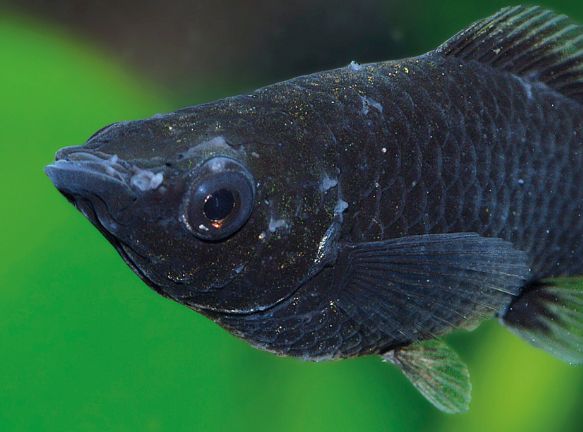
Graphite disease is very limited in the fish affected and the presentation. It MUST be a blue or black betta and the diseased patch MUST be graphite colored (i.e., very dark gray). If there is a true metallic dark gray patch (graphite colored) on a blue betta, then it is PROBABLY a type of mycobacteria which is untreatable. Black bettas will have whitish spots on them. But fin disintegration and whitish patches on any fish can also be bacterial (probably columnaris). The blue/black betta below probably has graphite disease, but it might also have columnaris. It is just impossible to tell.
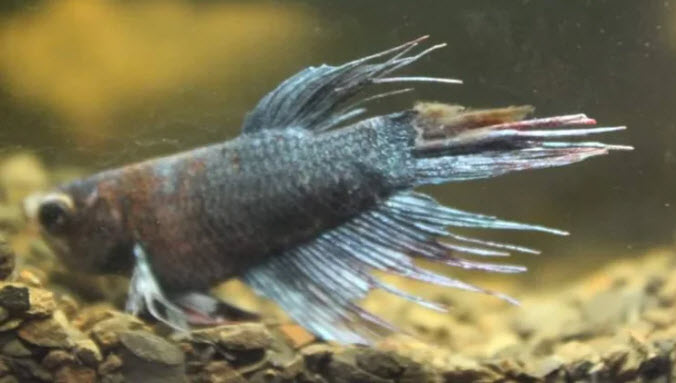
So far, two types of mycobacterial infections have been observed in Betta splendens. The first type is a relatively slow, chronic infection of environmental mycobacteriosis (typically mycobacterium marinum). The major defining symptom is the accumulation of internal granulomas, which can eventually cause the fish to appear lumpy/misshapen and swollen and are observable upon necropsy.
A second type of mycobacterium (a “mycolactone-producing mycobacteria” or MPM) produces an acute infection that typically causes death within days. A change in coloration, usually on the fins, occasionally on the body, is the first visible sign of an infection. The region initially turns a dark gray/graphite color that changes to black or complete color loss as the infected cells die. Fin rays and webbing disintegrate while scales lose partial to all pigmentation (“Mycobacteriosis in Fishes: A Review”, Gauthier, 2009, “Mycobacterium ulcerans and Other Mycolactone Producing Mycobacteria Should Be Considered a Single Species”, Pidot,et. al. 2010).
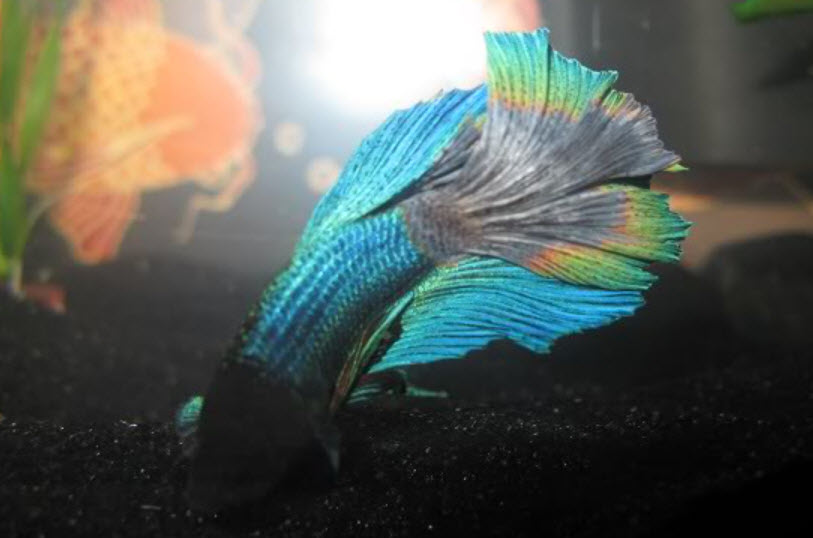
This infection seems to be limited to bettas which are completely blue, black or white in color, with no red, yellow or orange color in their coloration. The lack of carotenoid pigments seems to induce a genetic immune system disorder which predisposes these fish to this unusual mycobacteriosis. The diagnosis of mycobacteriosis for graphite disease in blue bettas has been confirmed by multiple fish necropsies at university research centers commissioned by two betta breeders who had plagues of this disease in their blue betta breeder tanks.
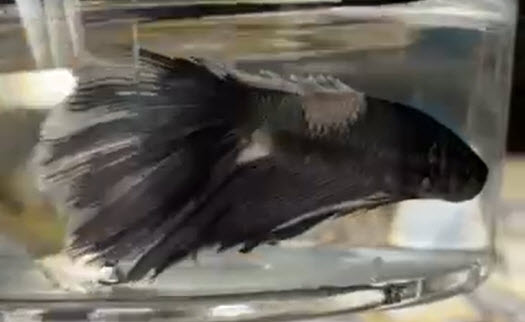
If the betta is a black or “copper” breed graphite will present as grey/white patches against a black background. The fish above PROBABLY has graphite disease. Note this disease presentation can also very easily be a columnaris or “saddleback” infection. It is impossible to differentiate the two with a visual examination.
What is important here is that the dark gray color comes on rapidly, in a matter of days. If the color has been there for months then it is probably just a genetically black coloration.
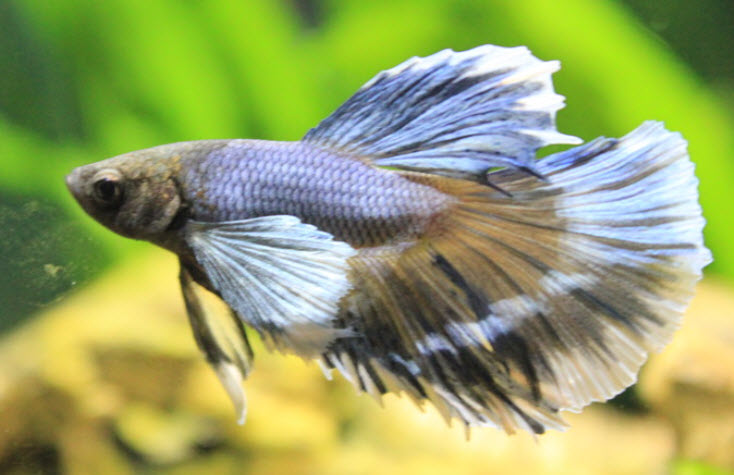
Treatment
There is no treatment for mycobacteriosis. But given that this identification is VERY tentative and many of these “graphite diseased” fish are probably infected with only a columnaris bacterial infection, I recommend treating with an antibiotic in the food and ONLY in the food.
.
Return to Diseases Menu
.
Aquarium Science Website
The chapters shown below or on the right side in maroon lead to close to 400 articles on all aspects of keeping a freshwater aquarium. These articles have NO links to profit making sites and are thus unbiased in their recommendations, unlike all the for-profit sites you will find with Google. Bookmark and browse!
.

Taylor H says
I think my betta Blueberry just died of this, and I’m devastated. One day he was fine, and literally the next morning a large part of his fins had just melted off. He died within a day or two, despite attempted treatment, with his fins continuing to just disintegrate, leaving actual fin chunks on the bottom of the hospital tank. He seemed to have chronic fin rot his whole life that kept coming back, but maybe it was a chronic mycobacterium infection, followed by an acute infection. It used to be that blue was the most common betta color! I had a blue betta growing up that was always healthy. I had never even heard of such a disease. I did not know when I bought my recent blue betta. RIP Blueberry. :’(
Dave says
In reply to Eve … Trying to sterilize out mycobacterium marinum can’t be done. As mycobacterium marinum is found literally everywhere (tap water, dust particles, fish bodies, gravel, etc.) it is pointless to even try to sterilize it out of any system. Mycobacterium marinum is very difficult to kill. So there is no need or even any point to getting a new tank. Just follow good filtration practices and feeding practices with your old tank and equipment and you should be just fine.
Eve Taylor says
I have a question in regards to a tank and equipment exposed/contaminated with mycobacterium marinum. My fish has been euthanized, I am getting a new tank, filter, plants and gravel. Using sodium chlorite – can I disinfect the heater and reuse it? Also – is there a way to safely disinfect the UV sterilizer?
(On a side note – is it ridiculous to get another Betta? do they all come with it?)
Thanks for any advice,
Eve
Dave says
In reply to Brian …… I’ve never had a fish “Take off” like that with that medicated food. Understand that prognosis is not good for your betta. Old age and graphite disease are generally fatal.
Brian Jones says
I made the medicine food as you described in your article (that gelatin smells bloody awful!) and gave some to my betta this morning. It is all white and has that graphite looking saddleback which then turns into a bright white (as he has gotten older he went from pure white to a pinkish hue, thats why the other white stands out so much). He ate the food and then since he has been zooming around the tank like something is chasing him. thats not normal for him and he has never done that till I gave him the food. I gave him about 2 pin heads worth of the medicine food. Any ideas on the “zoomies” ? Did I give him too much? My other non negative though is the medicine started attacking the parasite and didnt like it and he can “feel” that somehow but doesn’t know what it is… thanks for any help!
Dave says
In reply to Hollie …. Unknown
Hollie Cotner says
Can humans get this disease?